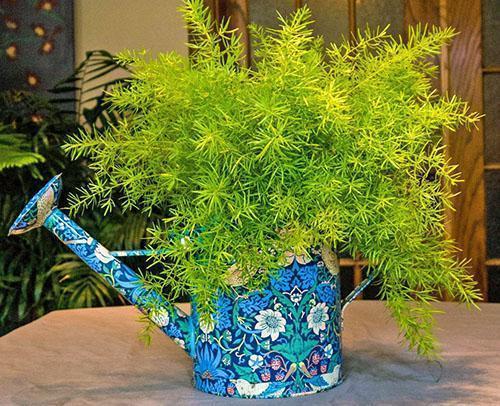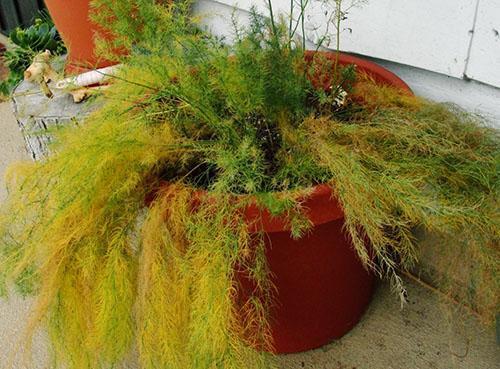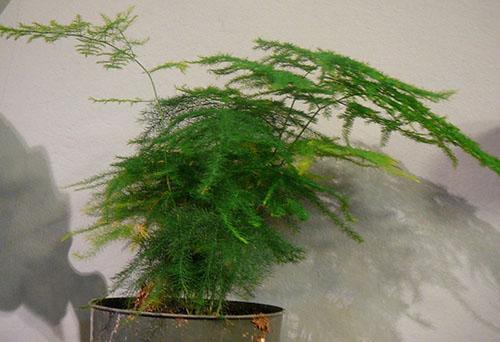How to properly care for someone with asparagus?
 Among the ornamental deciduous crops grown on home windowsills, asparagus occupy a special place. These hardy, fast-growing plants amaze not only with delicate greenery, but also with their amazing unpretentiousness. And yet, indoor plant lovers have to see how recently green asparagus turns yellow if phylloclades dry up and crumble.
Among the ornamental deciduous crops grown on home windowsills, asparagus occupy a special place. These hardy, fast-growing plants amaze not only with delicate greenery, but also with their amazing unpretentiousness. And yet, indoor plant lovers have to see how recently green asparagus turns yellow if phylloclades dry up and crumble.
What is the reason for this behavior of the plant, and what kind of care for a sick plant will restore its former beauty to asparagus?
Caring for asparagus that has begun to turn yellow or crumble

As practice shows, in most problems, mistakes in caring for asparagus or forgetfulness of the owner are to blame. Even the most hardy plant, accustomed to living in the dry air of an apartment, irregular or excessive watering, a cramped pot and other inconveniences, sooner or requires human attention. Asparagus is no exception, the patient culture does not immediately, but reacts to discomfort, stopping growing and turning yellow.
What if the asparagus dries up? Only by creating comfortable conditions for him, you can be sure of the health and constant beauty of the pet. And even a plant that has begun to dry out will start growing again. Therefore, it is necessary to correct the situation by analyzing the conditions of plant maintenance.
The reasons why asparagus turns yellow, and its "leaves" or phylloclades are crumbling, maybe a few.
 If the asparagus crumbles due to a chronic lack of moisture, the dried stems are cut off and gradually begin to moisten the soil in the pot. Dry soil is poorly saturated with water, so it is better to take several approaches. Over and over again, the substrate will get deeper and deeper until moisture saturates the entire volume of the pot, and its excess flows into the pan.
If the asparagus crumbles due to a chronic lack of moisture, the dried stems are cut off and gradually begin to moisten the soil in the pot. Dry soil is poorly saturated with water, so it is better to take several approaches. Over and over again, the substrate will get deeper and deeper until moisture saturates the entire volume of the pot, and its excess flows into the pan.
Having received the desired moisture, the plant will soon give new stems, and here, the main thing is not to disrupt the watering schedule.
It is best if the soil under the asparagus dries out between waterings, but does not turn to stone. The root system of the plant is designed in such a way that enough nutrients of water "in reserve" are accumulated in the nodules, but such accumulations come to an end. In addition, their depletion leads to the cessation of growth, which means that there is no need to wait for new leaves.
Excessive soil moisture also negatively affects asparagus. In a constantly humid warm environment, insects, bacteria and fungi easily multiply, which threatens the invasion of pests and asparagus diseases. Its powerful root system rots, and the fact that asparagus turns yellow is the result of an illness.
 Therefore, when leaving, it is extremely important to take into account the soil moisture at the time of watering, the air temperature in the room, because the plant "drinks" less in the cool, and the season. As a rule, specimens that release new shoots, flowering and set fruit specimens have a great need for moisture and nutrition.
Therefore, when leaving, it is extremely important to take into account the soil moisture at the time of watering, the air temperature in the room, because the plant "drinks" less in the cool, and the season. As a rule, specimens that release new shoots, flowering and set fruit specimens have a great need for moisture and nutrition.
You should not leave water in the pan, because its contact with the roots is one of the causes of asparagus disease and its shedding.
Dry indoor air damages most indoor plants, including all types of asparagus.Even periods of drought in nature are not as destructive to the plant as working heating devices in an apartment. Therefore, asparagus standing on windowsills or near batteries turn yellow even with preserved care and watering.
 You can stop the process by moving the pot away from the rising stream of hot air, as well as humidifying the air in the room with all available means. This will be useful not only for the flower, but also for people whose respiratory system and mucous membranes also dry up and cease to resist viral and colds.
You can stop the process by moving the pot away from the rising stream of hot air, as well as humidifying the air in the room with all available means. This will be useful not only for the flower, but also for people whose respiratory system and mucous membranes also dry up and cease to resist viral and colds.
When looking for a place for asparagus, it is worth remembering that not only hot air, but also a draft is harmful to this plant. Therefore, wondering why asparagus turns yellow, you need to check if it is blowing on it from the transom.
The optimal place for asparagus in an apartment is partial shade or a sunny windowsill, where the flower is protected from direct light. If the conditions created suit the plant, its cladodes are compact and lush. In the shade, the shoots lengthen, and the phylloclades on them are sparse. When the light is sorely lacking, for example, the pot is placed far from the window, even with proper care the asparagus turns yellow and loses its foliage.
 But the bright sun is not a plant's best friend. It leaves burns on the greens, causing asparagus to crumble in a matter of days. The situation is corrected by rearranging the pot and adjusting, if necessary, watering your green pet.
But the bright sun is not a plant's best friend. It leaves burns on the greens, causing asparagus to crumble in a matter of days. The situation is corrected by rearranging the pot and adjusting, if necessary, watering your green pet.
In most cases, by observing the plant, you can easily determine why its state of health changes, and what to do if the asparagus dries up in front of the grower.
Top dressing and new soil for sick asparagus
 But sometimes the cause of the disease is not so obvious. After all, even experienced flower growers do not always think that asparagus needs feeding, and they completely forget about the timely transplantation of the culture - the plant is so hardy and unpretentious.
But sometimes the cause of the disease is not so obvious. After all, even experienced flower growers do not always think that asparagus needs feeding, and they completely forget about the timely transplantation of the culture - the plant is so hardy and unpretentious.
The root system of asparagus is voluminous and rapidly growing, so in early spring the plants are transplanted into fresh soil. Moreover, for young specimens, the procedure is best performed annually, and adult asparagus are transferred to a new container after 2-3 years. If the grower forgot about replanting a pet, the roots and tubers come to the surface, the plant begins to experience an acute deficiency of nutrients and moisture. Asparagus will not turn yellow and crumble soon, but this will not affect the appearance and condition of the flower in the best way.
The transplant is also useful in that it helps to identify diseases and pests on the asparagus roots that have not yet made themselves felt or have already caused the stems to dry out.
 Top dressing is carried out in spring and summer, and here you need to take into account that asparagus love organic matter and nitrogen-containing mixtures, but an overabundance of this element can play a bad joke. A growth stimulant for greenery in a plant in the shade causes the shoots to stretch, and sometimes asparagus turns yellow from an excess of fertilizer. Therefore, it is useful for a pet to choose a fertilizer with a harmonious content of all nutritional components and trace elements.
Top dressing is carried out in spring and summer, and here you need to take into account that asparagus love organic matter and nitrogen-containing mixtures, but an overabundance of this element can play a bad joke. A growth stimulant for greenery in a plant in the shade causes the shoots to stretch, and sometimes asparagus turns yellow from an excess of fertilizer. Therefore, it is useful for a pet to choose a fertilizer with a harmonious content of all nutritional components and trace elements.
What to do with dying asparagus?
 When the yellowness of asparagus is not strong, for its recovery it is enough to resume watering, remove the plant from the shade, or, conversely, move it away from the sun, humidify the air or feed it. But a seriously ill asparagus plant needs special, comprehensive care. All lifeless stems are cut off from the drying asparagus, and then it is good to shed an earthen lump, it is useful to get the plant out of the pot and subject it to a thorough examination.
When the yellowness of asparagus is not strong, for its recovery it is enough to resume watering, remove the plant from the shade, or, conversely, move it away from the sun, humidify the air or feed it. But a seriously ill asparagus plant needs special, comprehensive care. All lifeless stems are cut off from the drying asparagus, and then it is good to shed an earthen lump, it is useful to get the plant out of the pot and subject it to a thorough examination.
If the roots are rotted, dried out and no longer come to life, such areas must be removed, leaving only light dense nodules that are still capable of giving new shoots. If necessary, the root system can be carefully divided and several young seedlings can be obtained at once, which will grow in a short time and become a decoration of the house.Asparagus planted in a nutritious loose substrate are watered and the soil is mulched from above. The roots that have preserved their vitality, subject to the rules of caring for asparagus, will soon show themselves and give growth.
Diseases and pests of asparagus
 Asparagus disease is often caused by pests that deplete the plant. Although the number of insects that can cope with the dense stems of the plant and its small phylloclades is not so great, with a massive defeat, asparagus turns yellow and can lose its decorative effect.
Asparagus disease is often caused by pests that deplete the plant. Although the number of insects that can cope with the dense stems of the plant and its small phylloclades is not so great, with a massive defeat, asparagus turns yellow and can lose its decorative effect.
The scutes on asparagus stems look like small raised plaques of a brownish or brownish tint. Feeding on the sap of the plant, they deplete asparagus, which leads to the yellowness of phylloclades. You can cope with an uninvited tenant by manually removing the shields or by carefully treating the clusters with actellik solution, diluting about 1-2 ml of the substance in a liter of water. In the future, when caring for asparagus, it is useful to spray the stems with settled water.
The same remedy is effective against spider mites, which rarely, but affects asparagus, which are kept in a dry room for a long time. These pests can pass from other plants, and are more often found on the branches of the stem or in the root zone. Weakening asparagus turns yellow, and with a lack of care, it can dry out. A good prevention will be regular irrigation of the crown with warm water and a shower for phyllocladia. True, it is better to cover the soil with such a procedure.
 But excess soil moisture in dry air provokes the development of thrips and mushroom mosquitoes. In this case, more than ever, it is important to take care of the asparagus and treat it with phytoverm or other insecticide. A similar measure is necessary if the asparagus, which is taken out into the garden in the summer, falls off. On such a plant, aphids can be found, which also bleed young stems.
But excess soil moisture in dry air provokes the development of thrips and mushroom mosquitoes. In this case, more than ever, it is important to take care of the asparagus and treat it with phytoverm or other insecticide. A similar measure is necessary if the asparagus, which is taken out into the garden in the summer, falls off. On such a plant, aphids can be found, which also bleed young stems.